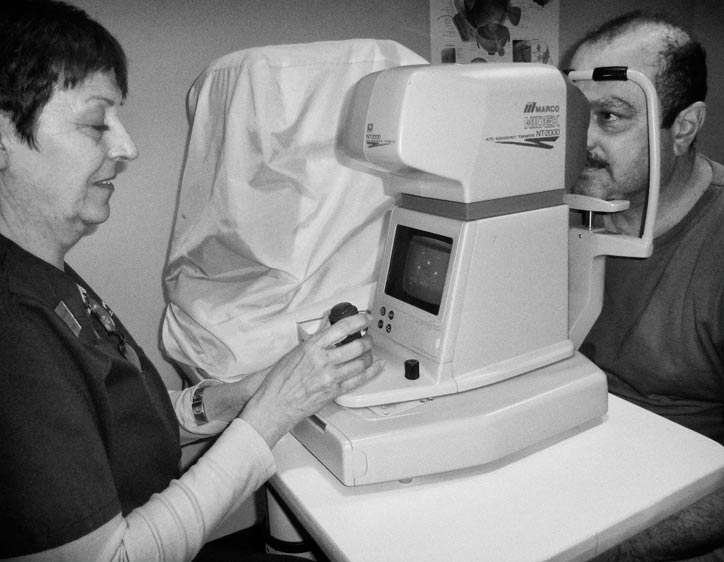Poof. Poof. It’s a brief puff of air per eye to test for glaucoma.
“Rest your chin against the unit, please.”
“Can you read this?” Slide. “What about this?”
Welcome to the typical eye exam.
It’s pain-free, quick and ensures that one of the most important senses you have is in perfect order.
 For those of us who wear glasses, the eye exam is an annual event. For those who’ve never had an eye exam and are now finding blurry newsprint, even when extending the newspaper at arm’s length, it’s time to see the eye doctor.
For those of us who wear glasses, the eye exam is an annual event. For those who’ve never had an eye exam and are now finding blurry newsprint, even when extending the newspaper at arm’s length, it’s time to see the eye doctor.
Here are the practical realities of the eye exam:
- No pain, lots to gain. It’s your eyesight. Treat with care.
- The lunch hour appointment? In about an hour, you can be in and out. The exam is thorough, yet quickly completed.
- Upon completion of the eye exam, your optometrist or ophthalmologist shares the findings. You need corrective lenses or you don’t. You may get a recommendation for glasses or the option of contact lenses.
- Checking your vision translates into an examination for “refractive errors,” these are conditions such as nearsightedness, farsightedness and astigmatism. In most cases, these are easily corrected with glasses, contact lenses or refractive eye surgery.
- The real purpose of an eye exam really isn’t about your eyesight, glasses or contacts. Its top value is to ensure that you don’t face a vision-threatening condition, ocular disease such as glaucoma, cataract, or macular degeneration.
- Sometimes when the prescriptions in each eye are significantly different from each other, the brain will compensate by ignoring the messages sent by one of the eyes. This condition, called amblyopic, can lead to permanent vision damage. If caught in early childhood, it may respond to wearing an eye patch over the stronger eye, sometimes surgery may be necessary. If detected too late, no treatment may be of benefit.
What else is your eye-care specialist looking for? It’s something called motion and synchronization. Crossed or “floating” eyes can lead to amblyopia—commonly referred to “lazy eye.” Sometimes, your two eyes may not sync, ever so slightly, resulting in double vision, headaches or eye strain.
Going Blind. Specialty Care & Children
It’s difficult to know if “going blind” is really happening because its symptoms are much like those who simply need corrective lenses. The only way to know is to have regularly scheduled eye exams (unless the blindness is sudden, in which case you should head to the emergency room). Most eye diseases leading to blindness are preventable when caught early.
Many people with specific health conditions may face early signs of eye disease. For example, diabetic patients may experience bleeding in their eyes and have some macular swelling. One-third of diabetic Americans aren’t aware that this could be a side effect. A simple, noninvasive eye exam can detect the symptom. If experienced, they should see their specialist or family doctor. In many cases, a regular eye exam can help diagnose potential risk for diabetes since part of the exam can include looking for signs of high blood pressure, high cholesterol and more.
Children really need regular exams. If a child is having learning problems at school or making written mistakes on paper, it could be nothing more than having poor vision. If they’re having headaches or sitting nose to nose with the TV, there are clues to poor vision.
Bottom line, enjoy your eyes. Take time to look around you and enjoy blue skies, vibrant-colored flowers, a person’s smile, and your kids’ creative drawing or Lego creations.
Eyesight is a gift. Stay on schedule with your eye exams. It’s worth the time, effort and money. Guaranteed.